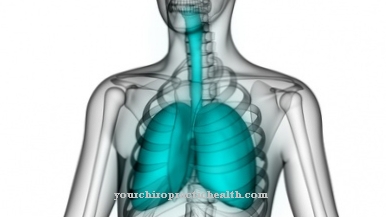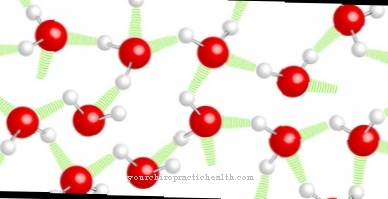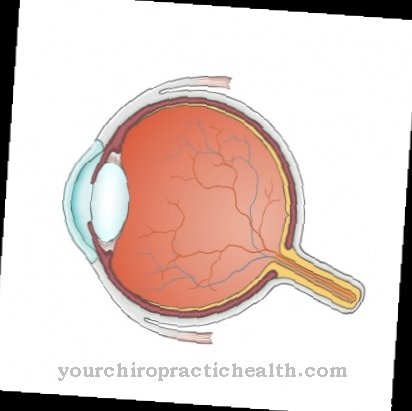The Glycolysis contains in humans and in almost all multicellular organisms a biocatalytically controlled breakdown of simple sugars such as D-glucose.
The process of degradation and conversion of glucose to pyruvate takes place in ten successive steps and can take place equally under aerobic and anaerobic conditions.
Glycolysis is used to generate energy, and pyruvate provides a first preliminary stage for the biochemical synthesis of certain substances. The breakdown of higher-quality carbohydrates (multiple sugars) also goes through glycolysis after being broken down into simple sugars.
What is glycolysis?

Glycolysis is a central metabolic process for the breakdown of the simple sugar D-glucose and takes place within the cells in the cytosol, the liquid part of the cell plasma. The degradation process takes place in 10 successive enzymatically controlled individual steps. The end products of the total balance from glycolysis per glucose molecule are 2 pyruvate molecules, 2 ATP nucleotides and 2 NADH nucleotides.
The 10 individual steps can be divided into two phases, the preparation phase from step 1 to step 5 and the amortization phase from step 6 to 10. The preparation phase is energetically negative for the metabolism, so that energy in the form of 2 ATP must be supplied. Only the amortization phase is energetically positive, so that on balance there is an energy gain in the form of 2 ATP nucleotides and 2 NADH nucleotides.
In the first two steps of glycolysis, 2 phosphate groups are transferred to the glucose, which come from 2 ATP nucleotides (adenosine triphosphate) and which are thereby converted into ADP nucleotides (adenosine diphosphate).
While the glycolysis up to the formation of the pyruvate is independent of whether oxic (aerobic) or anoxic (anaerobic) conditions prevail, the further metabolism of the pyruvate depends on whether oxygen is available or not. However, strictly speaking, the further breakdown and conversion processes no longer belong to glycolysis.
Function & task
Glycolysis is one of the most important and most frequent central metabolic processes that take place within a cell. The task and function of glycolysis consists in the energetic and material metabolism of the simple sugar D-glucose.
The ATP, which is obtained as part of the energy metabolism with the addition of energy and the transfer of a phosphate group to an ADP nucleotide, serves as an energy carrier and energy supplier. The route via the ATP has the advantage that the energy is stored briefly and is not lost through heat dissipation. In addition, the ATP can be brought to the place where the energy is needed over short distances.
The energetically positive glycolysis also provides the cell with pyruvate. It can either be introduced into the citric acid cycle and the subsequent respiratory chain by “consuming” oxygen under oxic conditions in the mitochondria of the cells for further energy generation, or it can be used as a starting material for the synthesis of required substances.
The main breakdown products in the citric acid cycle are CO2 (carbon dioxide) and H2O (water). The energy released during the oxidation process is used in the respiratory chain to phosphorylate ADP to ATP and is therefore stored for a short time.
The complete breakdown of glucose to water and carbon dioxide with the addition of oxygen is energetically more productive, but has the disadvantage that it can only take place under oxic conditions, i.e. under conditions under which molecular oxygen is available in sufficient quantities. When high performance of the skeletal muscles is required, the oxygen supply to the muscle cells is too slow, so that they have to draw the necessary energy from glycolysis.
Another advantage of glycolysis is its high process speed, which is many times the conversion speed within the citric acid cycle.
Illnesses & ailments
Glycolysis embodies one of the oldest and most stable metabolic processes of living organisms in evolutionary terms. Glycolysis was probably formed as one of the basic metabolic processes 3.5 billion years ago, long before the development of multicellular organisms, because all organisms are capable of glycolysis and use it to generate energy.
Only a few disorders or diseases are known that are explicitly associated with a glycolysis disorder. Disturbances in the glycolysis process lead primarily to serious effects on the red blood cells (erythrocytes).
Because they do not contain mitochondria, they rely on the supply of energy through glycolysis. If the energy supply is disturbed, hemolysis occurs, i.e. the membranes of the erythrocytes dissolve and the hemoglobin passes directly into the serum. There is usually a deficiency in the enzyme pyruvate kinase, so that the glycolysis process is interrupted.
Another cause that leads to similar symptoms can be found in the erythrocytes themselves if they do not have the necessary enzyme KKR (isoenzyme of pyruvate kinase).
Tarui's disease (Tarui disease) is one of the few diseases that directly disrupt the glycolysis process. It is a glycogen storage disease. Excess glucose in the blood serum is temporarily converted by the body into polymeric sugar (glycogen), which is later converted back into glucose if necessary, in order to be metabolized via glycolysis.
In the case of Tarui disease, an inherited genetic defect leads to a deficiency in phosphofructokinase, an enzyme that causes the phosphorylation and conversion of glucose into fructose-1,6-biphosphate (3rd step in glycolysis). The enzyme deficiency causes glycolysis to be interrupted so that the skeletal muscles are not properly supplied with energy.Painful muscle spasms and hemolytic anemia, the red blood cell membrane breaking down, develop.
























.jpg)



